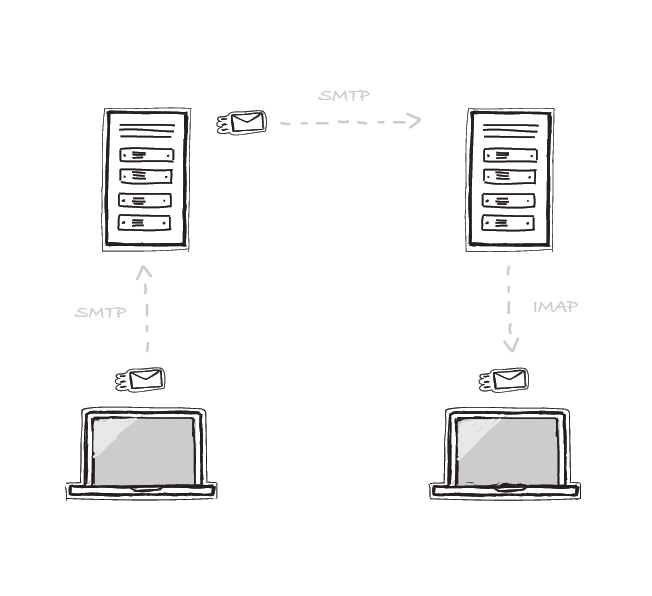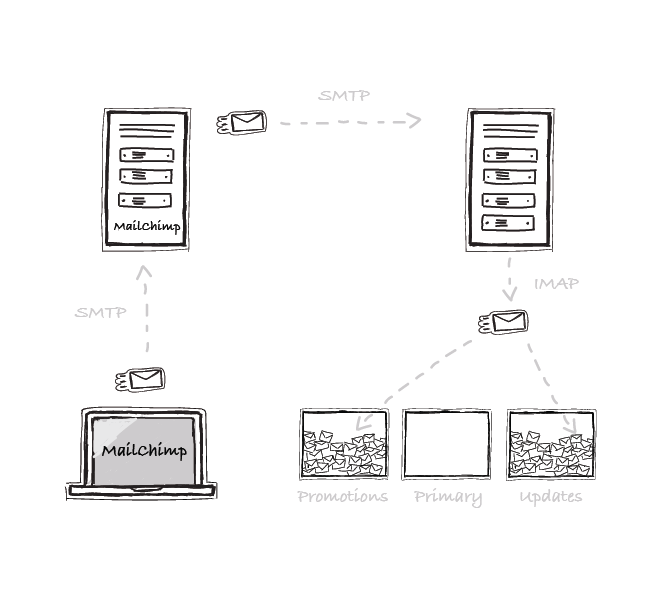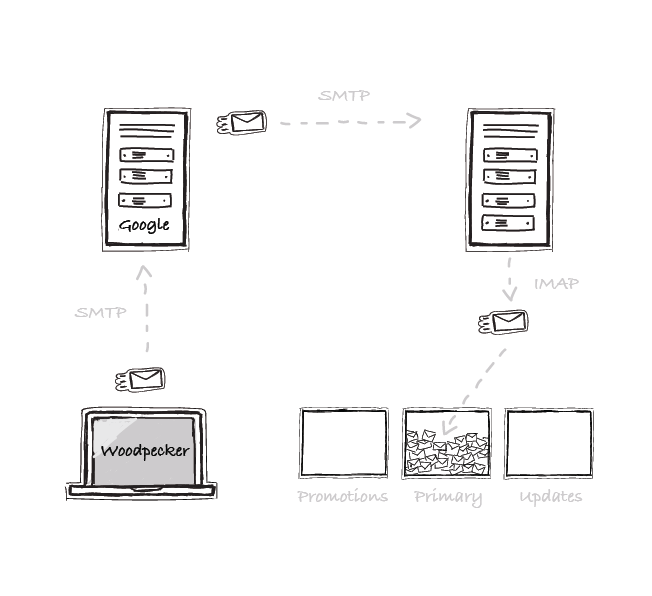SMTP & IMAP are the two main protocols that allow you to send and receive emails. Why am I even writing about this? Well, sometimes we take crucial things for granted. We use them every day and don’t ever think about how they work. I believe that this is one of such things. And I think that it’s worth understanding how sending your emails works, especially if you send a lot of them as a part of your job.
This will also allow you to understand better how email automation systems work, and how sales email automation systems, such as Woodpecker, differ from email marketing systems, like MailChimp or GetResponse. Read on to learn more about how SMTP and IMAP work for your email, or watch the video:
What is SMTP? How does it work?
Simple Message Transfer Protocol (SMTP) is what your email client (e.g. Gmail, Thunderbird, Outlook, etc.) uses to send your email messages to your email server. The email server is often hosted by your email service provider, for instance Google, but it can be also hosted by your Internet service provider (most often by the same one that hosts your domain). Next, SMTP is also used by the email server to send your message to the mailbox of your recipient’s email server.
What is IMAP? How does it work?
Internet Message Access Protocol (IMAP) is then used by the recipient’s email client to fetch your message from the email server and put it in their inbox.

Why is it good to know that?
We use email every day. According to a Radicati’s report, the number of business emails sent per day in 2017 is estimated at 120.4 billion. Every day! What’s interesting, the total daily number of emails sent worldwide is estimated at 225.3 billion. That means over a half of all email messages sent daily are actually business emails.
This technology still grows despite the onset of other means of communication online, like social media, chats, video chats, live streaming, and so on. That means people keep using it, even if they start using new ways of communication.
You definitely want your emails to be smoothly sent and safely delivered to their destinations – especially if they are business emails. Once you understand the mechanisms that are used to send and receive emails, you will be able to:
- take control over the process of your email delivery,
- better understand the mechanisms that affect your email deliverability,
- improve your deliverability and the engagement of your email recipients,
- and as a result, get more replies from interested prospects.
And those are the reasons behind this post.
SMTP & email automation
If you’re using email at work, there’s a high probability that you’re also using some kind of email automation. You may be, for instance, sending marketing emails or newsletters using a marketing automation tool like MailChimp, FreshMail, or GetResponse. Or you may use sales email automation for cold email sequences, using Woodpecker or similar tools.
Now, email marketing tools and sales email automation tools differ in terms of SMTP – that is, in terms of how they actually send your emails. And I really want you to know the difference because this will allow you to understand why you should use the right type of a tool for sending a specific type of email campaigns.
How does an email marketing tool send your emails?
First of all, email marketing tools, like MailChimp, host their own SMTP servers. That means, your marketing email campaigns won’t really get sent from your regular email server. Your addressee will see your address as the sender of the message, but the email won’t be sent from your mailbox.
Secondly, because email marketing tools use many servers for sending a lot of email at once, your messages will be sent very quickly, even if there’s a lot of them scheduled to be sent.
Finally, email marketing tools, like MailChimp, were designed to send newsletters, info about promotions, and updates. That is why the messages sent by those tools will get into the Promotions or Updates folders of your receivers’ inboxes.

Plus, even if you use a drip campaign option to send some follow-ups, your prospects’ replies won’t get detected, so the following messages will be sent to them even if they respond to one of your previous emails. And that’s a real bummer.
Why not use email marketing tools to send cold emails?
If your plan is to send an email with a beautiful HTML template, promoting your new service, or encouraging people to click a link to your new landing page, and you want to send it quickly to hundreds or thousands of subscribers (people who’ve previously opted in to get info via email from you), you should go for email marketing tools like MailChimp, ConvertKit, or FreshMail.
“Ok, but why can’t I send cold emails using these tools?” – if this question has just come to your mind, here are two convincing answers: 1.) Email marketing tools are not designed to send cold emails, and most of them do not allow this kind of email delivery in their terms of use. 2.) Even if you try sending your cold emails this way, and you won’t get caught, your cold emails will get to the Promotions or Updates tabs, where your prospects are less likely to open or read them, not least reply to them.
How does Woodpecker send your emails?
In terms of SMTP, Woodpecker is more similar to an email client than to a marketing automation tool. Woodpecker will actually use your own SMTP on your regular email server to send the messages. So the emails will be actually sent from your own mailbox.
That means you won’t be able to send hundreds or thousands of messages over a very short time period. Actually, you won’t be able to send even two messages at the very same moment. Your messages will be sent one by one, and sending a campaign to 40 people will actually take at least an hour (but it may take even more, depending on your delivery time settings).
As a result, your messages will be delivered straight to the Primary tab of your prospect’s mailbox. In there, they’ll be most likely to opened, read, and responded to.

And once the prospects respond, Woodpecker will detect that and stop the automatic follow-up sequence, so that they don’t get any messages they aren’t supposed to get. That’s why sending cold email campaigns from Woodpecker, or other similar tools designed for sales email automation, is actually more effective and safer.
Can I use a sales email automation tool to send a newsletter too?
If you plan to send a cold email sequence to people who haven’t subscribed to any of your lists and don’t know you yet, use a sales email automation tool like Woodpecker. This will allow you to get to the prospects’ primary inboxes and make sure that they don’t get any unnecessary automated follow-ups.
“Ok, so can I use Woodpecker to send my newsletters as well? I want my subscribers to notice them, open them, and engage with them!” – if you couldn’t stop this question from popping up in your mind, here’s an answer:
I wouldn’t use Woodpecker to send newsletters if I were you. First of all, I couldn’t send all of the planned marketing messages at the right time. Secondly, I couldn’t use any HTML templates to style the message. Third of all, I wouldn’t like my subsequent messages stopped from being sent in a case when someone replies to my newsletter (and that happens to me regularly).
How about an external SMTP?
External SMTP might work for you in some cases. For example, when you need to send an occasional high-frequency campaign, or when you’ve done everything by the book but still your deliverability suffers, and you think there might be an issue with your IP reputation.
In most cases, though, you don’t really need it. It is an additional cost, plus you need to take care of the advanced domain and DNS server configuration. Usually, your email service provider’s SMTP should be enough.
If you’d like to see if external SMTP service could be useful for you, check out our previous post that describes it in more detail.
Sendgrid and Mailgun are two examples of email providers that offer external SMTP service. Keep in mind, though, that they provide only an SMTP service, not IMAP.
See how to connect external SMTP from Mailgun and Sendgrid to Woodpecker.
Why is it important to understand how email works?
SMTP is used to send your messages. IMAP is used so you could receive them in your email client. Email is still a widely popular technology, especially in business environments – that’s why it’s important to understand how it works, at least in general.
Email marketing tools – designed to send newsletters, and sales automation tools – designed for sales email outreach, send your emails in a significantly different way. That’s why it’s crucial to use the right type of a tool for the right type of email delivery.
I hope this post clarified some of the technicalities of the email sending process, and that it will help you choose the right tools for sending various kinds of your business emails.
If you have 3 more minutes, read on the Difference Between Cold Emails and Marketing Emails >>
FAQs
What is the Internet Message Access Protocol (IMAP) and how does it work?
The Internet Message Access Protocol (IMAP) allows email clients to access and manage emails stored on a remote server. IMAP stores emails on the server, enabling users to view and organize their emails across multiple devices with an active internet connection.
How does the Simple Mail Transfer Protocol (SMTP) facilitate email sending?
The Simple Mail Transfer Protocol (SMTP) is used to send emails from the sender’s email client to the receiver’s mail server. The SMTP client connects to the SMTP server to transfer the message, which is then relayed to the recipient’s mail server using a mail transfer agent.
What is the difference between IMAP and POP3?
IMAP stores emails on a remote server, allowing users to access and manage their emails from multiple devices. In contrast, the Post Office Protocol version 3 (POP3) downloads emails from the server to a single device and deletes them from the server, making it less suitable for use on multiple devices.
How does an email client retrieve messages using the IMAP protocol?
An email client retrieves messages using the IMAP protocol by connecting to the IMAP server. The client can then access, read, and organize emails directly on the server, allowing synchronization across multiple devices.
What role does an SMTP server play in email communication?
An SMTP server is responsible for sending and relaying outgoing emails from the sender’s email client to the recipient’s mail server. It ensures that the email is correctly routed and delivered to the recipient’s mailbox.
How do email clients like Apple Mail support multiple devices?
Email clients like Apple Mail support multiple devices by using the IMAP protocol. This allows users to synchronize their email accounts across various devices, ensuring that any changes made on one device are reflected on others.
What is the Post Office Protocol version 3 (POP3), and how is it different from IMAP?
The Post Office Protocol version 3 (POP3) downloads emails from a remote server to a single device and then typically deletes the emails from the server. Unlike IMAP, which stores emails on the server and supports multiple devices, POP3 is intended for use on a single device.
How does an email client connect to a remote server using email protocols?
An email client connects to a remote server using email protocols like IMAP, POP3, and SMTP. IMAP and POP3 are used for retrieving emails, while SMTP is used for sending emails. The client communicates with the corresponding server to manage and transfer emails.
Why is the SMTP protocol important for sending emails?
The SMTP protocol is important for sending emails because it defines how emails are transmitted from the sender’s email client to the recipient’s mail server. It ensures that emails are correctly routed and delivered, enabling reliable email communication.
How do email protocols like IMAP and POP3 enhance email accessibility?
Email protocols like IMAP and POP3 enhance email accessibility by providing different methods for retrieving emails. IMAP allows for synchronized access across multiple devices, while POP3 is designed for downloading emails to a single device. Both protocols ensure that users can access their emails as needed.
READ ALSO

Woodpecker.co Quickstart Guide: How to set up a cold email campaign
Nifty cold emails work. Nifty cold emails with follow-up work miracles. But the sending cold emails by hand sucks because it takes way too much time. That’s not a made-up marketing scenario. That’s life. And if you’ve ever been sending your cold emails manually, you know that. We created Woodpecker because we had been sending our cold emails by hand and it was a problem we needed to solve. Now you can use our solution to fix it up for yourself. Here’s how to set up a cold email campaign in Woodpecker to automate outreach in a few simple steps.

External SMTP for Cold Emails – Can It Improve My Deliverability?
This one's about deliverability. And I'd say it's for more advanced email senders. I tried to explain things as simply as possible for everyone to get the idea behind the external SMTP services. Check what external SMTP is, when it's a good idea to use it, and if you could be interested in using it to send your cold emails.

4 Things You Need To Know When Choosing An Email Provider
There are a couple of things you need to pay attention to before you set up a separate email account for outbound. But first, what are the services that offer email accounts? The most popular email host among our users is Gmail. Then, we tend to spot accounts at Outlook, Zoho and GoDaddy. But you can also set up an account at Yahoo! Mail, AOL Mail, ProtonMail, Rackspace, and the like.

